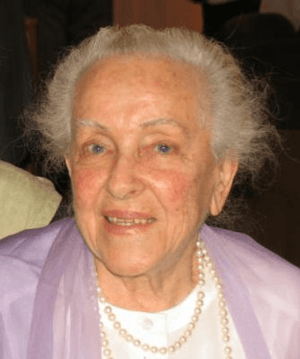Alexandra Paschalidou-Moreti facts for kids
Alexandra Paschalidou-Moreti, Greek: Αλεξάνδρα Πασχαλίδου-Μωρέτη (born in 1912 in Istanbul, died in 2010 in Filothei) was a famous Greek architect. She was well-known for designing many special buildings called "pavilions" for big international exhibitions around the world.
Contents
Early Life and Education
Alexandra Paschalidou-Moreti was the youngest daughter of Konstantinos Paschalidis and Despina Pappa. Her family moved a few times when she was young. They went from Istanbul to Bulgaria, then to Thessaloniki, and finally settled in Athens in 1925.
She grew up in a family where many people were artists, like architects and painters. Her large family had many talented members. Some of her famous relatives included the sculptor Giannis Pappas and painters like Eleni Pagkalou and Andreas Vourloumis. Her sister, Eleni Paschalidou, married the sculptor George Zongolopoulos. Another sister, Lili Paschalidou - Theodoridou, was a doll maker.
Alexandra started painting and drawing when she was very young. She studied at the Zappeio Girls School in Istanbul, which had a rich cultural environment. This helped her develop her artistic skills. When she moved to Athens, she continued her studies at the First Girls Gymnasium.
In 1932, she decided to study architecture at the National Technical University. She worked hard and, in 1936, she became the seventh woman in Greece to become a qualified architect. This was a big achievement for women at that time!
Her Career as an Architect
After becoming an architect in 1936, Alexandra Paschalidou-Moreti joined a special project. Her professor, Dimitris Pikionis, asked her to help study Greek traditional houses. She worked with Dimitris Moretis and Giorgos Giannoulelis. They were the first in Greece to study and draw the traditional architecture and decorations of houses from the 18th and 19th centuries. They focused on areas like Western Macedonia, Ipiros, Thessaly, Pindos, and the Cyclades islands.
Their work was shown in 1938, but it had to stop because of World War II. Later, some of their studies were published in books. These books showed the beautiful "Manor Houses of Kastoria" and "Houses of Zagora." More of their work is now at the National History Museum of Athens.
In 1938, Alexandra Paschalidou-Moreti organized the Greek Pavilion for the International Exhibition in Berlin. This was just the beginning of her work with exhibitions.
In 1939, she married Dimitris Moretis, who was also an architect, as well as a mathematician and poet. They had two children, Angelos and Irana, who both followed in their parents' footsteps and became architects too!
The Ministry of Press and Tourism asked Alexandra and Dimitris to design the Greek Pavilion for the 1939 New York World's Fair. They showed a large painting by the artist Nikos Eggonopoulos there. At this exhibition, and many others, they helped promote famous Greek artists like Nikos Xatzikiriakos-Gkikas, Spiros Vasileiou, Gerasimos Steris, Nelly's, and Voula Papaioannou.
During the Axis Occupation of Greece, Alexandra Paschalidou-Moreti took part in the Greek Resistance. She also researched and wrote studies about national and international exhibitions.
In 1951, she worked for the General Secretariat of Tourism. Her job was to help rebuild the exhibition center in Thessaloniki after the war. She traveled around Greece, documenting the damage from the war. Alexandra and Dimitris also designed many buildings for tourists. These included hotels, hostels, hiking stations, mountain huts, and spa facilities.
From 1937 to 1969, the Greek government trusted Alexandra and Dimitris to organize, study, and build 135 Greek Pavilions. These pavilions were for national and international exhibitions in 21 countries and 40 cities across four continents!
In 1969, Alexandra Paschalidou-Moreti resigned from her position.
From 1970 to 1976, she continued to design and build various structures. These included churches, apartment buildings, sports centers, and shops. She also worked on city planning projects for housing. She was very interested in the architecture of Greek islands like Kefalonia, Siros, Tinos, Naxos, and Paros. She created two volumes of drawings, texts, and photos about this work.
Alexandra Paschalidou-Moreti retired in 1976.
Sculpture and Written Works
Even after retiring, Alexandra Paschalidou-Moreti stayed very active. She created sculptures using clay and brass. When she was in her early 90s, she even learned how to use computer drawing programs!
She wrote many articles and studies about public art, interior design, and exhibitions. She also gave many talks in Greece and other countries. She often gave interviews to newspapers, radio, and TV. In these interviews, she mostly talked about the role of women and Greek architecture, both old and new.
Awards and Recognition
Alexandra Paschalidou-Moreti received many awards for her amazing work.
- In 1938, she won an award at the Universal Exhibition of Berlin.
- In 1939, she was made an "Honorary Citizen of the State of New York."
- In 1950, she received a prize at the International Exhibition of Thessaloniki.
- The state of Greece gave her the Prize of National Resistance.
- The City of Athens honored her in 1996 for her overall work.
- The Organization of Women Engineers gave her awards in 2000 and 2007.
From 2006 until she passed away in 2010, Alexandra Paschalidou-Moreti was the vice president of the George Zongolopoulos Foundation.
She was a member of many important groups, including the Architecture Department of the Greek Technical Chamber and the Architects Club. She was also part of international organizations like the International Union of Architects. She could speak three foreign languages: French, English, and Italian.
The documents and files of Dimitris Moretis and Alexandra Paschalidou-Moreti are now kept by their children. Some of their materials can also be found at the National History Museum of Athens, the Greek Literature and History Archives, and the Benaki Museum.


